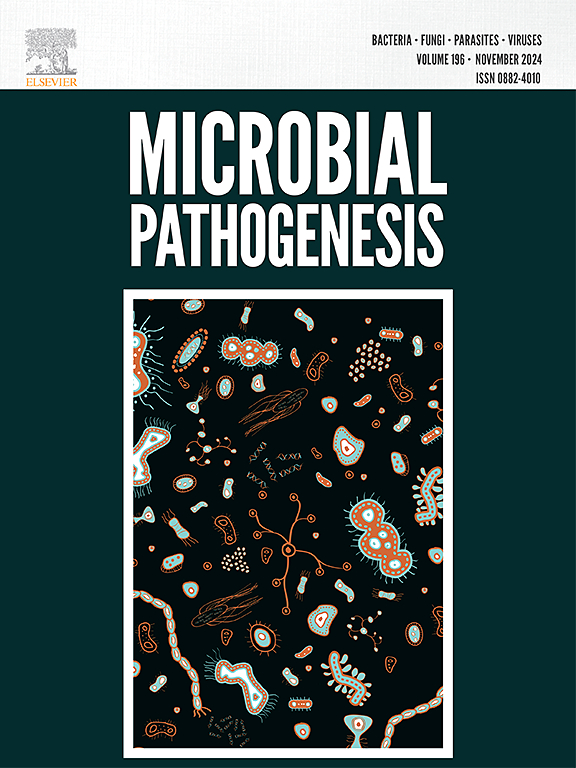Enhancing antibacterial efficacy and reducing the risk of antibiotic resistance of food-borne pathogen Cronobacter sakazakii by integrating essential oils with silver nanoparticles and antibiotics
IF 3.5
3区 医学
Q3 IMMUNOLOGY
引用次数: 0
Abstract
Cronobacter sakazakii is known as a food-poisoning bacterium that can withstand stressed environments. This study highlights the urgent need for effective antimicrobial alternatives by examining the emergence of antibiotic-resistant C. sakazakii in Egyptian dietary foods and the effects of essential plant oils and silver nanoparticles. The antibiotic susceptibility profiles of the fifteen C. sakazakii-positive samples were assessed using ten distinct antibiotics. Furthermore, a well diffusion method is used to estimate the minimum inhibitory concentrations of essential oils and silver nanoparticles. Scanning electron microscopy was also used to examine the morphological changes of the powerful antibiotic-resistant strain. Ipenem, ampicillin sulbactam, gentamicin, cefotaxime, ciprofloxacin, amikacin, ceftriaxone, and streptomycin were all resistant to C. sakazakii isolates, with a 100 % resistance incidence. They showed intermediate resistance to trimethoprim/sulfamethoxazole (80 % resistance incidence) and were only sensitive to norfloxacin (26.6 % resistance incidence). Essential oils (12–45 mm) were more successful in suppressing C. sakazakii than susceptible antibiotics (10.83–14.17 mm) and silver nanoparticles (7.17–12.25 mm). Higher inhibitions were provided by mint and basil oils, with mint oil exhibiting the best performance at 45 mm. The combination of antibiotics, silver nanoparticles, and essential oils demonstrated synergistic effects against powerful bacteria. Compared to clove + mint with trimethoprim/sulfamethoxazole (40 mm) or silver nanoparticles with basil oil (35 mm), mint-infused silver nanoparticles showed higher inhibition (45 mm). After being treated with basil oil, C. sakazakii showed morphological changes as seen by scanning electron microscopy. Combining essential oils with antibiotics and silver nanoparticles offers a viable way to counteract C. sakazakii's growing threat. In a medical environment that is becoming more complex, these developments offer hope for improving patient outcomes and safeguarding public health.
精油与纳米银颗粒及抗生素结合提高食源性病原菌阪崎克罗诺杆菌的抗菌效果及降低耐药风险
阪崎克罗诺杆菌是一种食物中毒细菌,可以承受压力环境。这项研究通过研究埃及饮食食品中出现的耐抗生素阪崎梭菌以及精油和纳米银的影响,强调了对有效抗菌替代品的迫切需要。采用10种不同的抗生素对15份阪崎梭菌阳性样品进行药敏分析。此外,采用孔扩散法估计精油和银纳米颗粒的最小抑制浓度。扫描电镜还检查了强抗生素耐药菌株的形态变化。伊培南、氨苄西林舒巴坦、庆大霉素、头孢噻肟、环丙沙星、阿米卡星、头孢曲松和链霉素对阪崎C.菌株均耐药,耐药率为100%。对甲氧苄啶/磺胺甲恶唑有中等耐药(80%耐药),仅对诺氟沙星敏感(26.6%耐药)。精油(12 ~ 45 mm)比敏感抗生素(10.83 ~ 14.17 mm)和纳米银(7.17 ~ 12.25 mm)对sakazakii的抑制效果更好。薄荷和罗勒油具有较高的抑制作用,其中薄荷油在45毫米处表现出最好的抑制作用。抗生素、纳米银粒子和精油的组合显示出对抗强大细菌的协同效应。与丁香+薄荷与甲氧苄啶/磺胺甲恶唑(40 mm)或银纳米颗粒与罗勒油(35 mm)相比,薄荷注入的银纳米颗粒具有更高的抑制作用(45 mm)。经罗勒油处理后,坂崎木参在扫描电镜下表现出形态变化。将精油与抗生素和纳米银颗粒结合起来,提供了一种可行的方法来对抗阪崎弧菌日益增长的威胁。在日益复杂的医疗环境中,这些发展为改善患者治疗结果和保障公众健康带来了希望。
本文章由计算机程序翻译,如有差异,请以英文原文为准。
求助全文
约1分钟内获得全文
求助全文
来源期刊

Microbial pathogenesis
医学-免疫学
CiteScore
7.40
自引率
2.60%
发文量
472
审稿时长
56 days
期刊介绍:
Microbial Pathogenesis publishes original contributions and reviews about the molecular and cellular mechanisms of infectious diseases. It covers microbiology, host-pathogen interaction and immunology related to infectious agents, including bacteria, fungi, viruses and protozoa. It also accepts papers in the field of clinical microbiology, with the exception of case reports.
Research Areas Include:
-Pathogenesis
-Virulence factors
-Host susceptibility or resistance
-Immune mechanisms
-Identification, cloning and sequencing of relevant genes
-Genetic studies
-Viruses, prokaryotic organisms and protozoa
-Microbiota
-Systems biology related to infectious diseases
-Targets for vaccine design (pre-clinical studies)
 求助内容:
求助内容: 应助结果提醒方式:
应助结果提醒方式:


